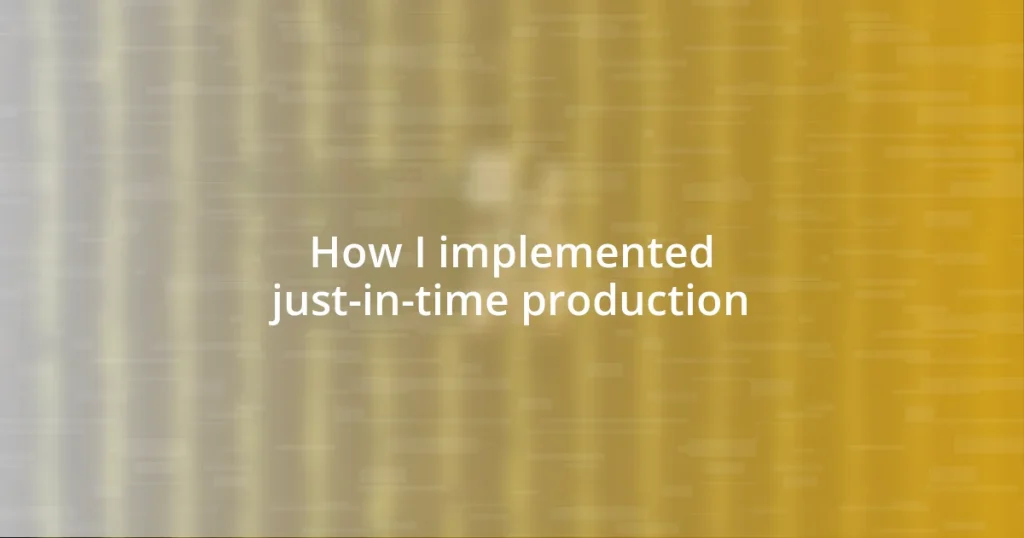Key takeaways:
- Just-in-time production (JIT) significantly reduces inventory costs and improves overall efficiency by aligning production with customer demand.
- Engaging team members and fostering open communication led to valuable insights and trust, essential for successful implementation of JIT.
- Continuous training and the use of tools like Kanban and integrated software systems enhanced visibility and adaptability within the production process.

Understanding just-in-time production
Just-in-time production (JIT) is a strategy aimed at minimizing waste by receiving goods only as they are needed in the production process. I remember the first time I implemented JIT; it felt a bit like a balancing act, trying to ensure we had everything we needed at the right moment without over-ordering supplies. I couldn’t help but wonder, how much could we save if we streamlined our inventory this way?
The beauty of JIT lies in its focus on efficiency and responsiveness to customer demand. I vividly recall a moment when we shifted to this methodology; it was both exhilarating and nerve-wracking. Suddenly, we were not just reacting to market trends, but anticipating needs, and I felt the adrenaline rush of being in sync with our customers’ expectations.
This approach not only reduces inventory costs but also improves product quality, as it encourages continuous improvement and quick adjustments. I often ask myself, what better way is there to remain competitive? It’s about creating a rhythm in production that feels both controlled and dynamic, where every part of the process aligns with the ultimate goal of satisfying the customer.

Benefits of just-in-time production
The benefits of just-in-time production are multifaceted. From my experience, one of the most striking advantages is the significant reduction in inventory costs. I recall a specific project where we eliminated excess stock, which not only saved us money but also opened up space in our warehouse. This newfound space allowed us to reorganize for efficiency—something that felt rewarding in both a practical and an emotional sense.
Here’s a quick list of additional benefits I’ve observed:
- Improved Cash Flow: Fewer funds tied up in inventory means more capital available for other activities.
- Enhanced Product Quality: Continuous improvement leads to fewer defects as teams focus on timely production and quality checks.
- Increased Flexibility: Companies can adapt quickly to changes in customer demand or market conditions.
- Strong Supplier Relationships: Collaborating closely with suppliers fosters trust and reliability.

Assessing current production processes
One of the first steps I took when assessing our current production processes was to map out every stage. I created a detailed process flowchart, pinpointing where delays and inefficiencies occurred. It was eye-opening; I discovered bottlenecks I hadn’t even realized were dragging us down. By identifying these areas, I was able to ask critical questions like, “How can we eliminate this delay without sacrificing quality?”
As I delved deeper, I engaged with team members at every level. Their insights were invaluable, revealing the underlying challenges that standard operating procedures often overlooked. I remember a conversation with a machine operator who pointed out that minor adjustments could save minutes that added up significantly by the end of the day. Listening to them not only helped me understand the production processes better, but it also made the team feel valued and part of the solution.
Finally, I began comparing our production metrics against industry benchmarks. This comparative analysis highlighted gaps between our current performance and where we could be. Seeing the data laid out in front of me was somewhat liberating; it provided a clear direction for improvement and set the stage for the implementation of JIT. By understanding where we stood, I felt empowered to make informed changes that truly aligned with our goals.
| Assessment Factors | Current Status |
|---|---|
| Production Time | Too many delays |
| Inventory Levels | Excess stock and waste |
| Team Engagement | Low input in process improvement |

Key steps for implementation
The first crucial step in implementing just-in-time production was streamlining our supply chain. I vividly remember working with our suppliers to create a more synchronized delivery schedule. It was a game-changer—no longer waiting weeks for material shipments meant we could produce exactly when needed. Have you ever felt that thrill of reducing waiting times? It makes a significant difference in the team’s morale.
Next, I focused on workplace organization using the 5S methodology: Sort, Set in order, Shine, Standardize, and Sustain. Implementing this strategy was both challenging and rewarding. I was amazed at how much a clean and organized work environment affected our productivity. I can still recall the moment we transformed a cluttered area into a streamlined workspace—everyone felt energized and committed, igniting a sense of pride in our surroundings.
Finally, I initiated continuous training for my team. I made it a point that everyone understood the ‘why’ behind just-in-time production. One afternoon, during a casual lunch discussion, team members shared their insights on improving workflow. That simple sharing session highlighted their expertise and encouraged innovative ideas to flow. Isn’t it fascinating how empowering a team can truly unlock their potential and drive success?

Tools for just-in-time production
Tools play a vital role in implementing just-in-time production effectively. One tool that truly made a difference for us was Kanban. I remember setting up a simple visual Kanban board that helped our team track inventory levels in real time. It was fascinating to see how a few colored cards could transform our entire management approach, enabling us to signal when more materials were needed without overstocking. Have you ever seen how clarity can rally a team?
Another important tool was the use of integrated software systems for inventory management. I decided to invest in a user-friendly platform that not only monitored stock levels but also provided real-time data on supplier delivery times. This investment felt like a leap of faith at first, but it quickly paid off. The newfound visibility allowed us to make swift adjustments on the fly, reducing waste, and keeping production seamless. I often think back to the day we first implemented this system; the sense of control and confidence it brought was palpable.
Additionally, we embraced value stream mapping, a tool that visually illustrates every step in the production process. As I walked my team through this diagram, it became clear where we could eliminate non-value-added steps. I can still recall the excitement in the room as we brainstormed ways to simplify our processes. Engaging everyone made it feel like we were on a shared journey, united in our goal to enhance efficiency. Isn’t it remarkable how collaboration can lead to clarity and innovation?

Measuring success and effectiveness
Measuring the success of just-in-time production is all about tracking key performance indicators (KPIs) that align with our goals. I recall the first time we analyzed our production lead times and realized we had cut them in half within just a month. That moment was electrifying—it demonstrated that our efforts were not only effective but transformative. How do you define success in your processes?
One of the most telling metrics for us was inventory turnover ratio. It was astonishing to see how effectively we moved products off the shelf and into the hands of customers. I remember celebrating a significant increase in this ratio during our weekly meetings; it felt like a collective win for the entire team. Each higher number became a badge of honor, motivating us further. This serves as an important reminder: tangible data can fuel enthusiasm and reinforce our shared mission.
Feedback loops also became crucial in measuring our effectiveness. After every production cycle, we held brief reflection sessions where team members shared their experiences and suggestions. I can still picture the animated discussions, where raw honesty paved the way for meaningful improvements. Isn’t it incredible how listening to your team can uncover insights that numbers alone might miss? This ongoing engagement connected us deeper to the mission, ensuring we were always on a path of continuous improvement.

Overcoming challenges in implementation
Implementing just-in-time production was not without its hurdles. I vividly recall a tense meeting where we faced resistance from a few long-standing team members. They were skeptical about changing processes that had worked for years, and their discomfort was palpable. But that challenge sparked a crucial turning point for us. I encouraged an open dialogue, where we could address their concerns. By acknowledging their feelings and involving them in the solution, we began to build trust. Isn’t it fascinating how vulnerability can pave the way for collaboration?
Communication gaps also surfaced during our early implementation stages. For instance, I discovered that our suppliers didn’t fully understand our new ordering timings, which led to delays. I’ll never forget the frustration I felt as we scrambled to manage production schedules on the fly. To overcome this, I took the initiative to organize a workshop with them. It was amazing to see how sharing our challenges led to a stronger partnership. Have you ever experienced how clarity in communication can transform relationships?
Lastly, I realized we needed to nurture a culture of adaptability. Early on, I noticed some team members struggling with the flexibility required in a just-in-time environment. Instead of simply pushing them to adapt or risk falling behind, we organized learning sessions focused on problem-solving techniques. It was empowering to witness the shift in mindset as team members embraced change. Have you ever felt the energy shift in a room when people unite towards a common goal? That collective enthusiasm made all the difference in overcoming our implementation challenges.















